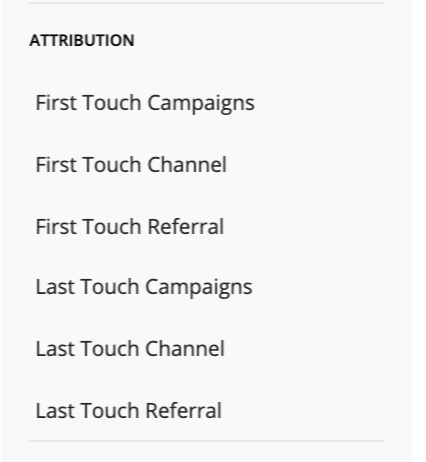Where is Peel collecting Attribution data from?
Attribution segmentation explained - Channels, Referral, Campaigns
Peel relies on Shopify’s handling of first and last visits to access Referrer and UTM data.

Shopify shares with us what they call CustomerJourney and it details referrals and UTM parameters.
Peel is collecting customer attribution data from Shopify. We gather the first and last visits for the first order of a customer from Shopify.
We then defined our own Channel mapping (inspired by Google Analytics) with 13 platforms so you can get the most accurate tracking of channel performance, without needing to set up the channel mapping yourself required in Google Analytics or other data platforms.
With a full subscription, you get access to all the segments, including:
Channels: We defined mapping of the 19 most common traffic sources for easier analysis.
Days to conversion: The number of days between first touch (or visit) and the order purchase.
Landing page: URL of the first page the customer landed on for any session associated with the order.
Referrer: URL of the previous web page from which a link was followed.
UTMs: Source, Medium, Campaign, Content, and Term
Definition of Channels
- Text Messaging
- UTM source = 'postscript', 'attentive'
- UTM medium = 'text'
- Instagram Paid
- Shopify source = 'Instagram'
- referrer contains = 'instagram.com'
- UTM source = 'instagram', 'Instagram'
- UTM medium = "paidsocial", "paid-social", "paid_social", "Paid Social", "cpc", "ppc"
- Instagram Organic
- Shopify source = 'Instagram'
- referrer contains = 'instagram.com'
- UTM source = 'instagram', 'Instagram'
- Facebook Paid
- Shopify source = 'Facebook'
- referrer contains 'facebook.com'
- UTM source = "facebook", "Facebook"
- UTM medium = "paidsocial", "paid-social", "paid_social", "Paid Social", "cpc", "ppc"
- Facebook Organic
- Shopify source = 'Facebook'
- referrer contains 'facebook.com'
- UTM source = "facebook", "Facebook"
- Pinterest
- Shopify source = 'Pinterest'
- referrer contains 'pinterest.com'
- UTM source = "pinterest", "Pinterest"
- Youtube
- Shopify source contains 'youtube'
- referrer contains 'youtube.com'
- Twitter
- referrer contains "/t.co"
- TikTok Paid
- Shopify source = 'TikTok'
- referrer contains = 'tiktok.com'
- UTM source = "tiktok", "Tiktok", "TikTok"
- medium = "paidsocial", "paid-social", "paid_social", "Paid Social", "cpc", "ppc"
- TikTok Organic
- source = 'TikTok'
- source contains = 'tiktok.com'
- UTM source = "tiktok", "Tiktok", "TikTok"
- Snapchat Paid
- Shopify source = 'Snapchat'
- referrer contains = 'snapchat.com'
- UTM source = "snapchat", "Snapchat"
- medium = "paidsocial", "paid-social", "paid_social", "Paid Social", "paid|social", "cpc", "ppc"
- Snapchat Organic
- Shopify source = 'Snapchat'
- referrer contains = 'snapchat.com'
- UTM source = "snapchat", "Snapchat"
- Referral
- UTM medium = 'referral'
- UTM source = 'referral'
- Paid Search
- UTM source = 'adwords'
- UTM medium = 'cpc', 'ppc', 'paidsearch'
- referrer contains "googleadservices"
- Affiliate
- UTM source = "affiliate", "affiliates", "shareasale", "pepperjam", "awin"
- UTM medium = 'affiliate', 'affiliates', 'aff'
- Email
- Shopify source = 'email'
- UTM source = 'email'
- UTM medium contains 'email'
- Referrer = "com.google.android.gm" (Gmail app on Android)
- Online Advertising
- UTM medium = 'cpv', 'cpa', 'cpp', 'content-text', 'display', 'cpm', 'banner'
- Organic Search
- Shopify source = 'Google', 'Bing', 'Yahoo', 'DuckDuckGo'
- referrer contains 'bing.com'
- referrer contains 'duckduckgo.com'
- referrer contains 'search.yahoo.com'
- Shop App
- referrer contains 'shop.app'
- referrer contains 'pay.shopify.com'
- Direct
- Shopify source = 'direct'
- Offline
- All orders with no web sessions (subscriptions, draft orders, admin, etc.)
- Other / Unknown
- Everything else we couldn't identify with the rules above
An Example
Imagine you have daily SMS text messages blasting to your customer base. You know these people love your product, because you have a solid amount of customer loyalty with repeat purchases. When you implement UTM codes to track this data though, it turns out that you get very few regular conversions from your SMS campaigns. But, you notice that your monthly newsletter + loyalty offers email campaign is absolutely on fire with conversions, especially when the subject line mentions an offer.
In this example, maybe a daily text message isn’t the secret recipe. Maybe this is telling you to pull back on the daily engagement and focus on 1 or 2 pieces of direct engagement per month. Or, since the campaign content is so vastly different from the ones in the SMS, maybe you should try another experiment to see if it is the campaign or the medium. Maybe it tells you that your loyalty offers are a sweet spot for your business as people respond to these campaigns.
If it is “Other” it means we/Shopify doesn’t know where it came from.
Take-Aways
You can answer the following questions and more with attribution segmentation:
-
Are customers that found us through Facebook worth more than those from Google or affiliates?
==> LTV by Attribution Channel / AOV by Attribution Channel / ROAS by Attribution Channel -
If I spent $100K in ads last month, am I making that back in revenue from new customers?
==> New Sales by campaign or channel / New Subscription revenue by campaign or channel / New transaction revenue by campaign or channel -
Which campaign drew in the most revenue? Was it worth the investment?
Updated 7 months ago